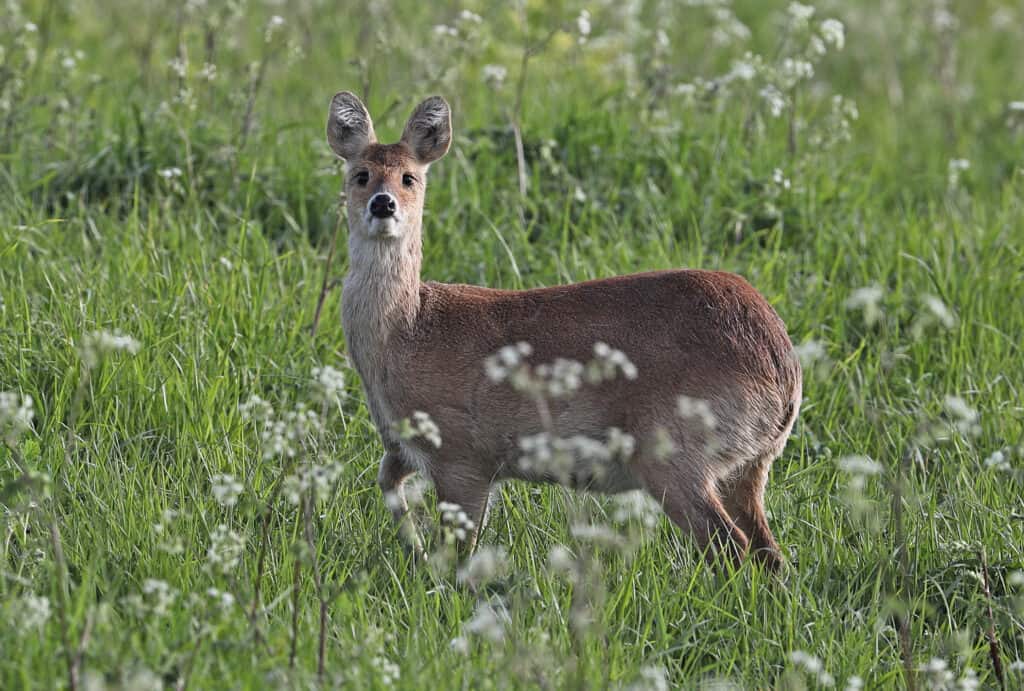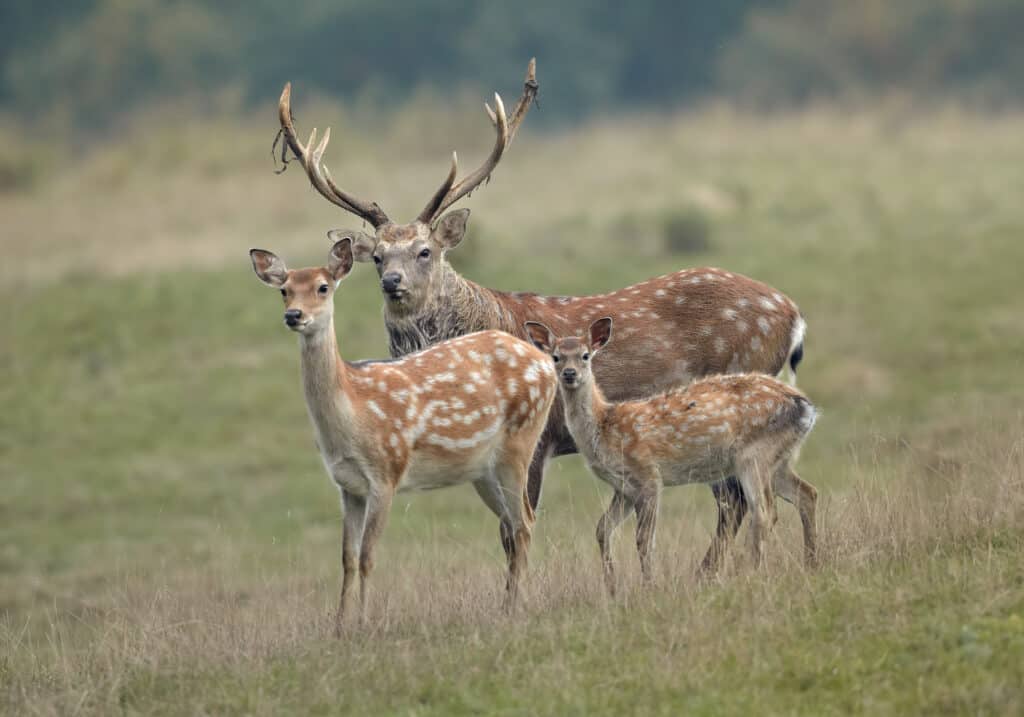Did you know that “doe” isn’t the only term you can use when referring to female deer? You can also call them cows (yes, like for cattle!) or hinds!
Although “doe” is perfectly acceptable to be used regarding all deer species if you aren’t sure how old the deer is and what species you’re talking about, there are some scientific nuances between these three terms.
Moreover, if we call male and female deer by different names, there must be some behavior dissimilarities, too, right? Keep reading to find out the answers!
What Do You Call a Female Deer?

: A female deer is generally called a doe.
©iStock.com/Neil Bowman
While it’s totally fine to call a female deer just a female deer, there are other designated terms to use when talking about them. The most common term is “doe.” However, this isn’t the only term! Female deer have several names that are used depending on the species. The other two are “hind and cow.” Let’s learn more about each!
What Deer Do We Call Does?
“Doe” is the most known and common name people use for female deer. It is the counterpart of the male term “buck.” It’s an Old English word with a Celtic reference. This word is also used for females from other animal species, such as rabbits or kangaroos.
To be more precise, does are medium-sized or small deer. You can use “doe” when referring to European roe deer, fallow deer, Chinese water deer, and muntjac females. Some sources state that using “doe” for all female deer species at any age is correct, especially if one doesn’t know much about the deer.
What Deer Do We Call Hinds?
“Hind” is the term used for larger deer species and is most commonly used as a counterpart of “stag,” which is used when referring to male deer. It’s an Old Germanic or Dutch term. You can call a female red deer or sika deer a hind. Moreover, this term is most often used for deer two years of age or older.
What Deer Do We Call Cows?
As odd as it may sound, some female deer are called cows – yes, just like for cattle! Their male counterparts are called bulls. Female North American elk (wapiti), caribou, and moose deer are cows. Hence, we can conclude that this term is used for the largest deer species. Compared to does and hinds, cows are much heavier, weighing up to 600 pounds or more.
Female Deer Names By Species
Here’s what female deer are called in various deer species:
| Term for Females | Species |
|---|---|
| Doe | Brocket deer Fallow deer Mule deer Muntjac Roe deer Tufted deer Water deer White-tail deer Spotted deer |
| Hind | Red deer Moose Sambar |
| Cow | Elk Moose Reindeer |
Additionally, we’ve prepared some details on how you’d call the males and the babies from certain species:
| Term for Males | Species |
|---|---|
| Buck | Brocket deer Fallow deer Mule deerMuntjac Musk deer Roe deer (roebuck) Tufted deer Water deer White-tailed deer |
| Stag | Brocket deer Red deer Sambar Spotted deer White-tailed deer |
| Bull | Elk Moose Reindeer |
| Term for Offspring | Species |
|---|---|
| Calf | Elk Moose Reindeer |
| Fawn | Brocket deer Fallow deer Mule deer Muntjac Musk deer Roe deer Spotted deer Tufted deer Water deer White-tailed deer Red deer |
Female Deer Behavior

Female deer use their front feet to show dominance and fight other does.
©WildMedia/Shutterstock.com
It is well known that male deer are much more aggressive than female deer. Studies showed that they display five intimidation postures depending on how much aggressiveness they want to display:
- Ear drop – the mildest posture
- A hard look, with the head and neck extended and the ears, flattened along the neck
- The sidle body – the buck’s head and body are turned about thirty degrees from the other male deer; the head is erect, the chin is tucked in, and the hair on the neck and hips is raised; the buck advances slowly with sliding steps
- The antler threat – the male deer drops his head and presents its antlers
- The rush – if the other buck displays its antlers, too, they rush one towards the other and make violent contact with their antlers.
All clear for the male deer. But since females do not have antlers and do not have to fight to mate, are they aggressive?
Yes, female deer also display aggressive behavior. They use the ear drop, the hard look, and the sidle body postures. Instead of antlers, female deer use their front feet to show dominance and fight the other doe. Then, they stand up on their hind legs and fight with their front legs.
However, males are much more solitary than females, except for the mating season. Females, on the other hand, won’t mind living and traveling in groups.
How To Tell Male and Female Deer Apart

The most important distinction between male and female deer is the absence of antlers in females.
©Martin Mecnarowski/Shutterstock.com
If you’ve spotted a deer and aren’t sure whether it was a male or a female, we’re here to help! Moreover, we’ll offer a tip on how to understand whether you’re following female or male deer tracks!
Male Deer vs. Female Deer: Antlers and Appearance
The most important distinction between male and female deer is the fact that females have no antlers. So if you spot a deer without antlers, it’s definitely a female. However! Yes, there’s a “however.” Reindeer females have antlers! Still, this shouldn’t be a problem anyway, because you’ll probably be able to tell a female reindeer from a male. After all, their antlers are usually much shorter and less branched than a bull’s.
Another easy way to distinguish between male and female deer is their size. Most male deer are larger than females.
Male Deer vs. Female Deer: Tracks
Female deer legs are closer together than male legs. So if you’re following some deer tracks and you notice they go on a straight, narrow line, they belong to a doe, a hind, or a cow. If the line is wider, you’re following the tracks of a buck, a stag, or a bull.
Up Next:
- Deer Mating Season: When Do They Breed?
- Spike Deer: What It Means & When You’ll See Them
- Everything You Want To Know About Muntjac Deer Face Scent Glands
The photo featured at the top of this post is © WildMedia/Shutterstock.com
Sources
- World Deer, Available here: https://worlddeer.org/what-is-a-female-deer-called/
- Eating The Wild, Available here: https://eatingthewild.com/what-is-a-female-deer-called/
- Daily Science Journal, Available here: https://www.dailysciencejournal.com/the-proper-terms-for-calling-male-female-baby-and-groups-of-deer/
- AnimalsPick, Available here: https://animalspick.com/what-is-a-female-deer-called/
Thank you for reading! Have some feedback for us? Contact the AZ Animals editorial team.






